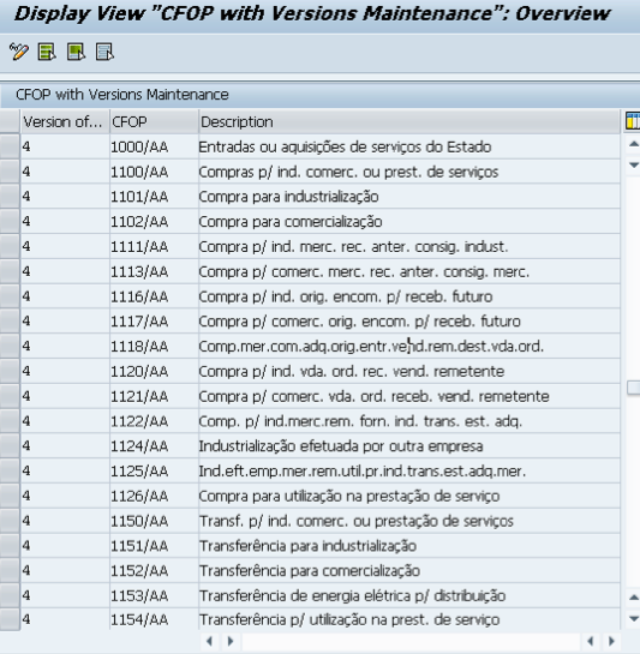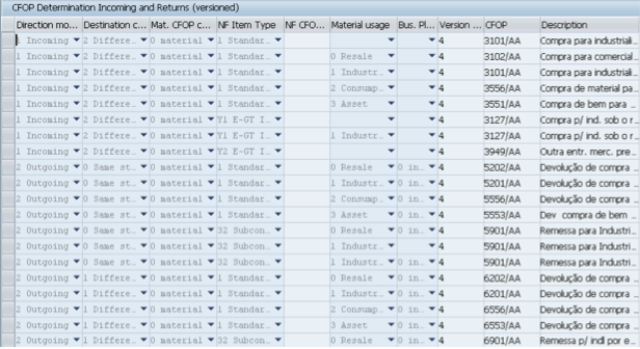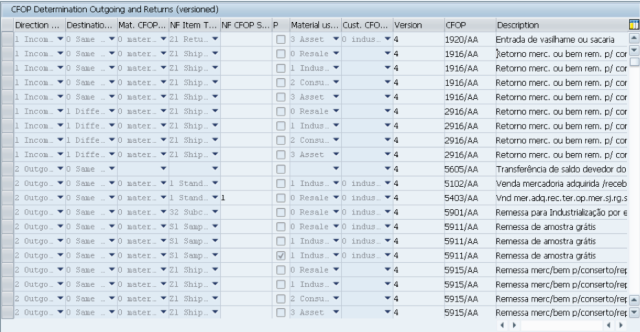
- SAP Community
- Products and Technology
- Enterprise Resource Planning
- ERP Blogs by Members
- Configuring CFOP on SAP
- Subscribe to RSS Feed
- Mark as New
- Mark as Read
- Bookmark
- Subscribe
- Printer Friendly Page
- Report Inappropriate Content
This blog post is a sequence of CFOP – Fiscal Code of Operations and Services
Now that you know what does CFOP means and what is used for, it is time to know how to configure the CFOP on SAP in 5 steps:
1 – Define CFOP Version
The first activity necessary is “DEFINE CFOP VERSIONS” and you can do that either maintaining the table/view J_1BCFOPVERV or via IMG path “Cross-Application Components > General Application Functions > Nota fiscal > CFOP Codes > Define CFOP Versions”.
Now a days it is not necessary to maintain the old CFOP length version anymore, then, enter the following data:
- Version: 1
- Description for CFOP Version: NEW CFOP 4 DIGITS
- Redeterm.: Considering your SAP installation is new, you don’t have the old CFOP format (replaced in 2003), then, it is not necessary to activate this check.
- CFOP Lngth: 4 CFOP Length
- Ext. Lngth: 0 No Extention
- Text ID: AA (or anything such as: A, 01, etc)
2 – Assign validity date to CFOP Versions
Once you have created the CFOP version, it is time to assign the validity date to the version created. Here you can also assign a version to a region (state) if required.
Follow the path “IMG > Cross-Application Components > General Application Functions > Nota fiscal > CFOP Codes > Assign Validity Date to CFOP Versions” or use the SM30 to maintain the table/view J_1BCFOP_XREGNV.
Type Valid-From, Country, Version.
3 – Define CFOP Codes and Assign Version
You can maintain the view J_1BAGNV or follow the customizing path: IMG > Cross-Application Components > General Application Functions > Nota fiscal > CFOP Codes > Define CFOP Codes and Assign Version
The CFOP codes and respective descriptions are part of a legal system to define the exactly operation for every goods movement going from or coming to the plant or company in Brazil.
You should ask for a full list of CFOP codes and description to the company Taxes and Fiscal department. You may want to ask me adding a comment here and I will forward it to you.
Check a sample below:
4 – Define CFOP Determination for Goods Receipts and returns
In this activity, you define the entries in the CFOP determination table for incoming movements (goods receipts) and their returns. The system uses these entries in the Materials Management components Logistics Invoice Verification and Inventory Management. The rules from this table will define automatically the correct CFOP for that specific operation during the goods incoming.
You can use the view J_1BAONV or the path IMG > Cross-Application Components > General Application Functions > Nota fiscal > CFOP Codes > Define CFOP Determination for Goods Receipts and Returns (Versioned)
See below an example:
5 – Define CFOP Determination for Goods Issue and returns
You define the entries in the CFOP determination table for outgoing movements (goods issues) and their returns. The system uses these entries in Sales and Distribution and Materials Management – Inventory Management. The rules from this table will define automatically the correct CFOP for that specific operation during the goods incoming.
You can do it maintain the view J_1BAPNV or via customizing menu: IMG > Cross-Application Components > General Application Functions >Nota fiscal > CFOP Codes > Define CFOP Determination for Goods Issues and Returns (Versioned)
See an example below:
You can find more details about CFOP checking SAP OSS Note 571848.
- SAP Managed Tags:
- FIN (Finance)
You must be a registered user to add a comment. If you've already registered, sign in. Otherwise, register and sign in.
-
"mm02"
1 -
A_PurchaseOrderItem additional fields
1 -
ABAP
1 -
ABAP Extensibility
1 -
ACCOSTRATE
1 -
ACDOCP
1 -
Adding your country in SPRO - Project Administration
1 -
Advance Return Management
1 -
AI and RPA in SAP Upgrades
1 -
Approval Workflows
1 -
Ariba
1 -
ARM
1 -
ASN
1 -
Asset Management
1 -
Associations in CDS Views
1 -
auditlog
1 -
Authorization
1 -
Availability date
1 -
Azure Center for SAP Solutions
1 -
AzureSentinel
2 -
Bank
1 -
BAPI_SALESORDER_CREATEFROMDAT2
1 -
BRF+
1 -
BRFPLUS
1 -
Bundled Cloud Services
1 -
business participation
1 -
Business Processes
1 -
CAPM
1 -
Carbon
1 -
Cental Finance
1 -
CFIN
1 -
CFIN Document Splitting
1 -
Cloud ALM
1 -
Cloud Integration
1 -
condition contract management
1 -
Connection - The default connection string cannot be used.
1 -
Custom Table Creation
1 -
Customer Screen in Production Order
1 -
Data Quality Management
1 -
Date required
1 -
Decisions
1 -
desafios4hana
1 -
Developing with SAP Integration Suite
1 -
Direct Outbound Delivery
1 -
DMOVE2S4
1 -
EAM
1 -
EDI
3 -
EDI 850
1 -
EDI 856
1 -
edocument
1 -
EHS Product Structure
1 -
Emergency Access Management
1 -
Energy
1 -
EPC
1 -
Financial Operations
1 -
Find
1 -
FINSSKF
1 -
Fiori
1 -
Flexible Workflow
1 -
Gas
1 -
Gen AI enabled SAP Upgrades
1 -
General
1 -
generate_xlsx_file
1 -
Getting Started
1 -
HomogeneousDMO
1 -
IDOC
2 -
Integration
1 -
Learning Content
2 -
LogicApps
2 -
low touchproject
1 -
Maintenance
1 -
management
1 -
Material creation
1 -
Material Management
1 -
MD04
1 -
MD61
1 -
methodology
1 -
Microsoft
2 -
MicrosoftSentinel
2 -
Migration
1 -
mm purchasing
1 -
MRP
1 -
MS Teams
2 -
MT940
1 -
Newcomer
1 -
Notifications
1 -
Oil
1 -
open connectors
1 -
Order Change Log
1 -
ORDERS
2 -
OSS Note 390635
1 -
outbound delivery
1 -
outsourcing
1 -
PCE
1 -
Permit to Work
1 -
PIR Consumption Mode
1 -
PIR's
1 -
PIRs
1 -
PIRs Consumption
1 -
PIRs Reduction
1 -
Plan Independent Requirement
1 -
Premium Plus
1 -
pricing
1 -
Primavera P6
1 -
Process Excellence
1 -
Process Management
1 -
Process Order Change Log
1 -
Process purchase requisitions
1 -
Product Information
1 -
Production Order Change Log
1 -
purchase order
1 -
Purchase requisition
1 -
Purchasing Lead Time
1 -
Redwood for SAP Job execution Setup
1 -
RISE with SAP
1 -
RisewithSAP
1 -
Rizing
1 -
S4 Cost Center Planning
1 -
S4 HANA
1 -
S4HANA
3 -
Sales and Distribution
1 -
Sales Commission
1 -
sales order
1 -
SAP
2 -
SAP Best Practices
1 -
SAP Build
1 -
SAP Build apps
1 -
SAP Cloud ALM
1 -
SAP Data Quality Management
1 -
SAP Maintenance resource scheduling
2 -
SAP Note 390635
1 -
SAP S4HANA
2 -
SAP S4HANA Cloud private edition
1 -
SAP Upgrade Automation
1 -
SAP WCM
1 -
SAP Work Clearance Management
1 -
Schedule Agreement
1 -
SDM
1 -
security
2 -
Settlement Management
1 -
soar
2 -
Sourcing and Procurement
1 -
SSIS
1 -
SU01
1 -
SUM2.0SP17
1 -
SUMDMO
1 -
Teams
2 -
User Administration
1 -
User Participation
1 -
Utilities
1 -
va01
1 -
vendor
1 -
vl01n
1 -
vl02n
1 -
WCM
1 -
X12 850
1 -
xlsx_file_abap
1 -
YTD|MTD|QTD in CDs views using Date Function
1
- « Previous
- Next »
- Configuration of protocols in Enterprise Resource Planning Q&A
- License Type Configuration Vs. Item Category in Enterprise Resource Planning Q&A
- SPRO configuration to track changes to Batch master field MCHA-SGT_SCAT(stock segment) in Enterprise Resource Planning Q&A
- Advance Return Management complete configuration(SAP ARM) in Enterprise Resource Planning Blogs by Members
- Integration of SAP Service and Asset Manager(SSAM) with SAP FSM to support S/4HANA Service Processes in Enterprise Resource Planning Blogs by SAP
| User | Count |
|---|---|
| 5 | |
| 2 | |
| 2 | |
| 2 | |
| 2 | |
| 2 | |
| 2 | |
| 1 | |
| 1 | |
| 1 |




